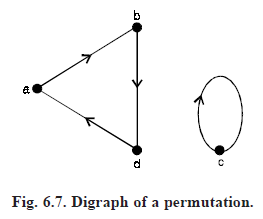SKEDSOFT
PERMUTATION: On a finite set A of some objects, a permutation π is a one-to-one mapping from A onto intself.
For example, consider a set {a, b, c, d}.
A permutation π1 =  takes a into b, b into d, c into c, and d into a. Alternating, we could write π1(a) = b, π1(b) = d, π1(c) = c, π1(d) = a.
takes a into b, b into d, c into c, and d into a. Alternating, we could write π1(a) = b, π1(b) = d, π1(c) = c, π1(d) = a.
The number of elements in the object set on which a permutation acts is called the degree of the permutation.
For example, the permutation π1 =  is represented diagrammatically by Figure 6.7 below :
is represented diagrammatically by Figure 6.7 below :

Permutation  can be written as (a b d) (c).
can be written as (a b d) (c).
The number of edges in a permutation cycle is called the length of the cycle in the permutation.
A permutation π of degree k is said to be of type (σ1, σ2, ...... σk) if π has σi cycles of length i for u = 1, 2, ..... k.
For example, permutation is of type (2, 0, 2, 0, 0, 0, 0, 0).
Clearly, 1σ1 2σ2 3σ3 ..... kσk = k.
COMPOSITION OF PERMUTATION
Consider the two permutations π1 and π2 on an object set {1, 2, 3, 4, 5} : π1 = 
and π2 = 
.
A composition of these two permutations π2π1 is another permutation obtained by first applying π1 and then applying π2 on the resultant.
That, is
π2π1(1) = π2(2) = 4
π2π1(2) = π2(1) = 3
π2π1(3) = π2(4) = 2
π2π1(4) = π2(5) = 5
π2π1(5) = π2(3) = 1
Thus π2π1 = 